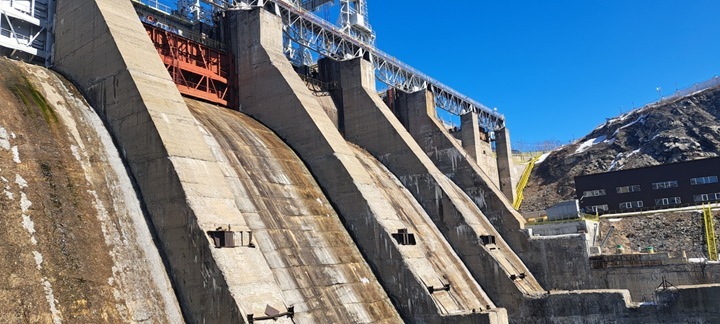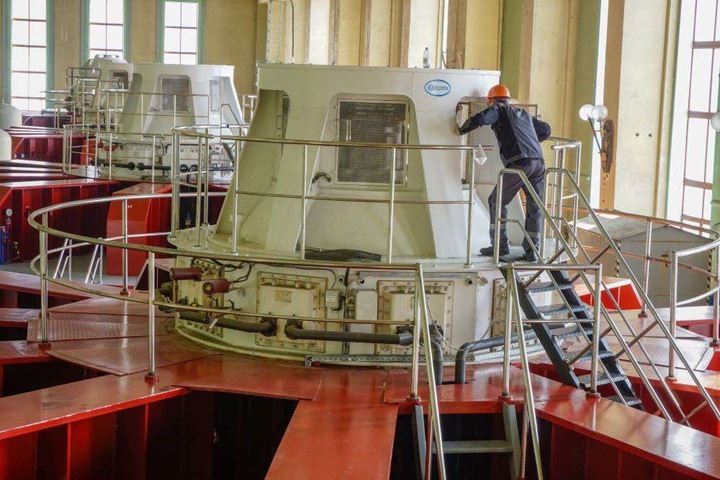Management of the Irtysh: floods, modernization of HPPs and the fate of the river
Floods are, according to specialists of the Ust-Kamenogorsk HPP, a key stage related to water level regulation, ecosystem protection and safety. As noted by Svetlana Nishchenko, Chief PR and GR manager of Ust-Kamenogorsk HPP, the volume of water to be discharged by the hydroelectric power station, as well as the start date of the release, is determined by a permanent interdepartmental commission in the first decade of April. This decision is made on the basis of the forecast of lateral inflow of RSE “Kazhydromet”. Also, the participants of the press tour were told about the modernization of the hydroelectric units of the station and what changed after the transfer of 100% of the shares of AES Ust-Kamenogorsk HPP LLP and AES Shulbinskaya HPP LLP to the subsidiary of the subsidiary of Samruk-Energo JSC – Qazaq Green Power PLC (QGP).

How to attract investors
As Svetlana Nishchenko explained, the enterprises have moved to a structure that unites producers of “clean” energy. They are still working according to the same standards, requirements, and regulatory documents. All the requirements that were imposed on power facilities of this type have been preserved.
“Qazaq Green Power is a public company, the “green” portfolio of JSC “Samruk-Kazyna”, – said the general director of LLP “AES Ust-Kamenogorsk HPP” and LLP “AES Shulbinskaya HPP” Tlek Aidabulov. – In addition to our two stations, it includes Shardarinskaya, Moynakskaya HPPs and wind farms. Absolutely nothing changes for us in terms of management. QGP is engaged in projects, in the future it will attract investors and also participate in the construction of new stations. The potential of the Irtysh today is about 4.2 GW of installed capacity, about 1.8 GW of effective capacity that can be realized. And how to do it? It is necessary to attract an investor. And what should the Kazakh side participate in? She must participate with the guaranteed assets that she has. Most likely, it will be us (Ust-Kamenogorsk and Shulbinskaya HPPs).”
According to Tlek Aydabulov, in the portfolio of Samruk-Kazyna, its subsidiary Qazaq Green Power, there is a ready-made pre-TEO for the Semipalatinsk HPP, and the implementation of this project can be started within the framework of EPCF contracts. Also, a feasibility study of the second stage is planned at the Shulbinskaya HPP. If now its capacity is 700 MW, then the second stage will give an additional 350 MW.
“In addition, further along the Irtysh, it is possible to install Belokamenskaya, Pavlodar, and some other stations. About 10 HPPs can be supplied. Now these companies are moving towards the future. The projects are difficult, quite complex, because these are the flooding of the relevant territories, the withdrawal of land plots, the transfer, the construction of new settlements, the transfer of roads, engineering structures,” said Tlek Aidabulov, adding that the projects for the construction of hydroelectric power stations are very expensive.
A record figure
155 people are currently working at the Ust-Kamenogorsk HPP. The production staff is 80%, the administrative staff is 20%. In 2024, the hydroelectric power plant generated more than 1.8 billion kWh of electricity, and Tlek Aidabulov called this a “good” indicator. The average annual level is 1.5 billion kWh.
“It was due to the high water content. Last year on the Chinese side there was a dam breakthrough of about 5 cubic km. All this went into our Bukhtarma reservoir. And, accordingly, with high water content and with a large lateral inflow on the Kazakh side, we “worked” this water in generator mode, – added Tlek Aidabulov. – Last year we achieved a record capacity utilization rate of 58% at the Shulba HPP – 26%.”
In the tariff component, the share of Ust-Kamenogorsk HPP last year was equal to 3.44 tenge, this year the tariff amounted to 4.29 tenge per 1 kW/hour. The second source of income is the power market. According to Tlek Aydabulov, the HPP participates in auctions.
“If in 2023 the price on the power market was 590 tenge per kW, then this year the starting price was equal to 1065 tenge per kW, and we contracted for 1060 tenge. We spend our earnings on modernization without fail. For example, there are four hydroelectric power units at the Ust-Kamenogorsk HPP. The first, second and third are completely modernized, except for the working blades. But these are details. Now we are upgrading the fourth car. We have placed an order in Russia for the manufacture of the impeller and rotor — this is the heart inside the stator. Delivery will begin next year. In 2026, we are already carrying out repairs, and in 2027 we plan to upgrade and deliver the fourth car.”
At the same time, Tlek Aidabulov stressed that the capacity of the fourth hydroelectric unit after repair will increase by 12 megawatts. The implementation period is 2024-2027. The estimated cost of repair is 11.8 billion tenge.
On each of the three already upgraded machines, there was an increase in power by 12 MW, to 96 MW. For comparison, the entire Turgusun HPP produces an average of less than 25 MW annually.
By the way, after the repair, they want to install the old fourth hydroelectric unit weighing more than a hundred tons in the Left-Bank Park of Ust-Kamenogorsk as a monument.
Ust-Kamenogorsk HPP plans to cover the dam with a special material to avoid leaks, strengthen concrete together with the European company Carpi.
Also, Tlek Aidabulov complained that there are energy problems associated with a shortage of personnel at the Ust-Kamenogorsk HPP. But the fluidity is minimal – about 5%. Employees have a good social package, now the hydroelectric power plant plans to reimburse the costs of hot meals for all staff by about 80%. In February of this year, the HPP reached 10 thousand days without accidents with the contractor and 5.5 thousand days with the staff. There are protocol instructions from the managing Directorate of JSC “Samruk Energy” to increase expenses in the field of safety by 30%. One of the know-how is the organization of work with full video recording. Video surveillance is installed on the helmet of each employee, and the information is transmitted to a common server, where it will be analyzed. In addition, there will be an electronic medical examination system, where the general condition of a person will be determined by the pupils of the eyes, pulse.
Flood as a test of strength
During the press tour, journalists were shown an engine room with four hydraulic units, a one-person bomb shelter left over from the Cold War, a control panel, a control room, an automatic diagnostics and control system, an internet–processing room at the bottom of the HPP building, in fact, a tunnel under water that provides collection, removal of leaks, spillway dams. They also showed how the daily inspection is conducted with the measurement of the water level, the temperature of the lower reaches using a device – a “flapper”.
“Ust-Kamenogorsk HPP is a counterregulator of Bukhtarminskaya HPP. How much she dumped, exactly the same amount we will pass through our hydroelectric power station. We have no lateral inflow, the Ust-Kamenogorsk reservoir is not replenished additionally,” Svetlana Nishchenko noted. — Lateral inflow is what flows downstream, water from the mountains, snowmelt, and the Shulba reservoir receives more water. They have a larger discharge of water, which is difficult to predict. It all depends on the weather. For a hydroelectric power station, a flood is a time X when everything is tested for strength. The spillway dams – which we are raising – are a picture that should not be there. The water must pass in generator mode.”
Olga Ushakova (inbusiness.kz )


